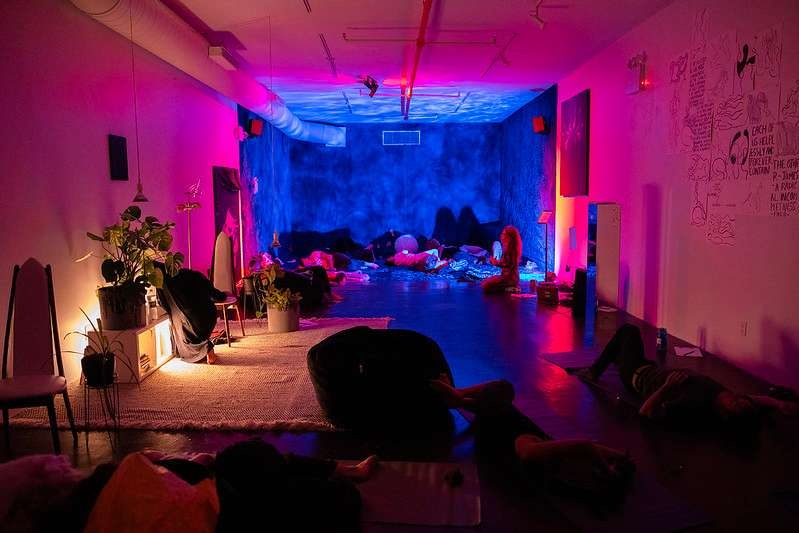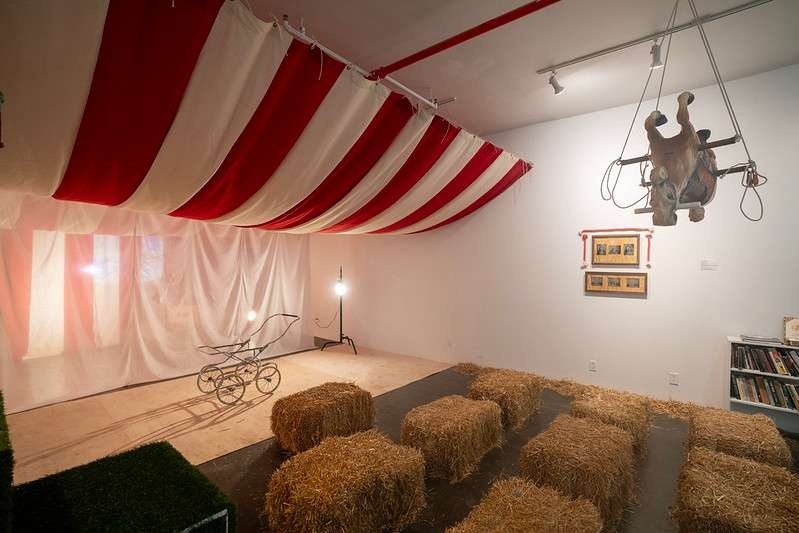On a warm August afternoon, I am dancing with and for my friend Camilo Godoy in his ISCP residency studio space. Nfasis is blasting from the speakers while Camilo shoots rapid candids of my movements, which are at first small and hesitant. Still nursing a heartbreak, I feel guarded in my nearly naked body, having shielded myself from most acts of intimacy in the recent months. Eventually, through laughter and conversation, I find my rhythm and loosen up enough for Camilo to capture my relaxed and coy expression in the photograph that appears in the first edition of his project Amigxs, a collection of images of friends and lovers in various states of movement and physical connection.
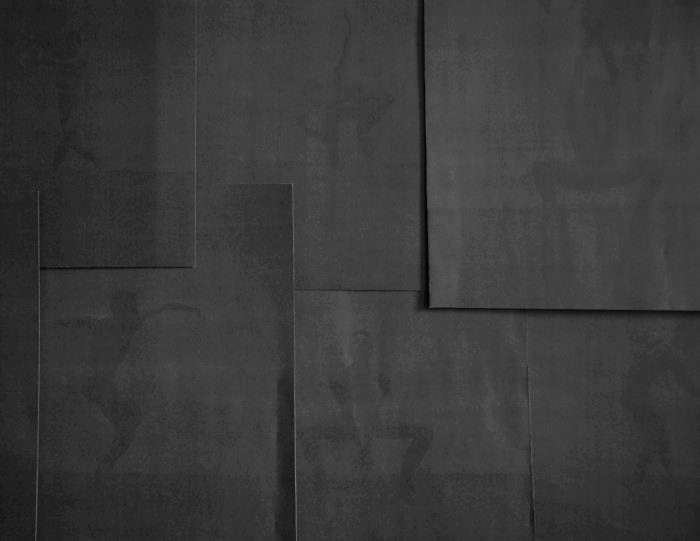

What did they actually see?, 2018, black and white photograph, 8.5” x 11”.
I am comforted to find myself in this community of known and unknown friends. Estamos juntxs by the simple act of being gathered together on the page. A few months later, on a cold November night, Camilo huddles a group near the billboard version of one of these photographs: Amigxs (Self-portrait with Brendan Mahoney, Carlos Martiel and Jorge Sánchez). The four interwoven friends, hands and lips and skin intermingling, are magnified to a spectacular scale as Camilo reads a passage by David Wojnarowicz in which the artist describes a sexual encounter near the West 37th Street and 9th Avenue corner where the billboard stands.
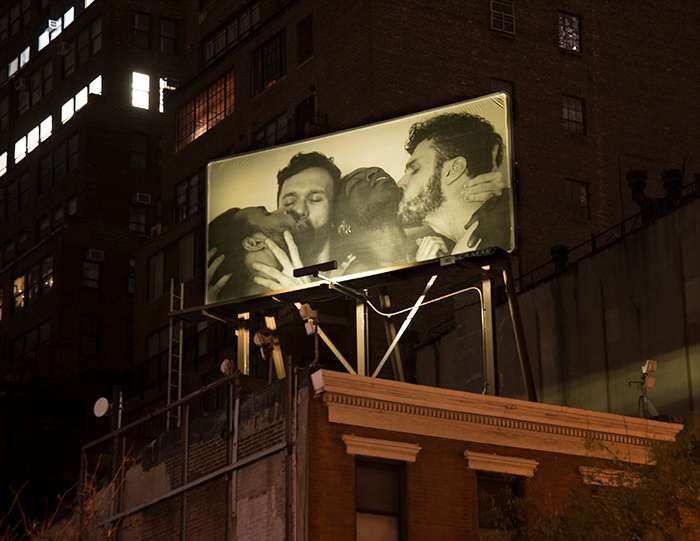

Amigxs (Self-portrait with Brendan Mahoney, Carlos Martiel and Jorge Sánchez), 2017. Billboard, 264” x 120”.
Installation view in Midtown Manhattan.
Speaking Wojnarowicz’s words with the billboard overhead – itself reminiscent of another patron saint of queer intimacy, Félix González-Torres – Camilo charged this unremarkable corner with the presence of queer public sex and with the intimate reverberations of huddling in the cold together, witnessing these vulnerable words. Camilo’s work often feels both embedded in the social landscape and mapped within the body. In witnessing his work, I am made aware of the varied ways we seek connection with ourselves, with each other, and with the world around us.
Camilo’s Recess Session feels a lot like his broader practice: a deliberate frame holding many intricacies and histories that remains malleable and pliable. Rather than fill the space with oversized mirrors that typically line dance studios, Camilo covers the walls with a reflective mylar that leads to beautiful, unexpected distortions as one moves in front of it. Whereas one grows accustomed—even bound—to monitoring one’s movements in the traditional dance studio’s mirror, here, in Camilo’s studio, one’s reflection becomes defiantly unreliable.
This is even more so because the mylar “mirror” is highly susceptible to its environment: changes in light, creases, oiled imprints from fingers that have pressed against it. At one point, the light bouncing off the mylar creates a projection on the wall the way an undulating pool of water would. This aquatic light show reflects back onto the surface of the mylar in turn, the two nearly mirror images of each other.
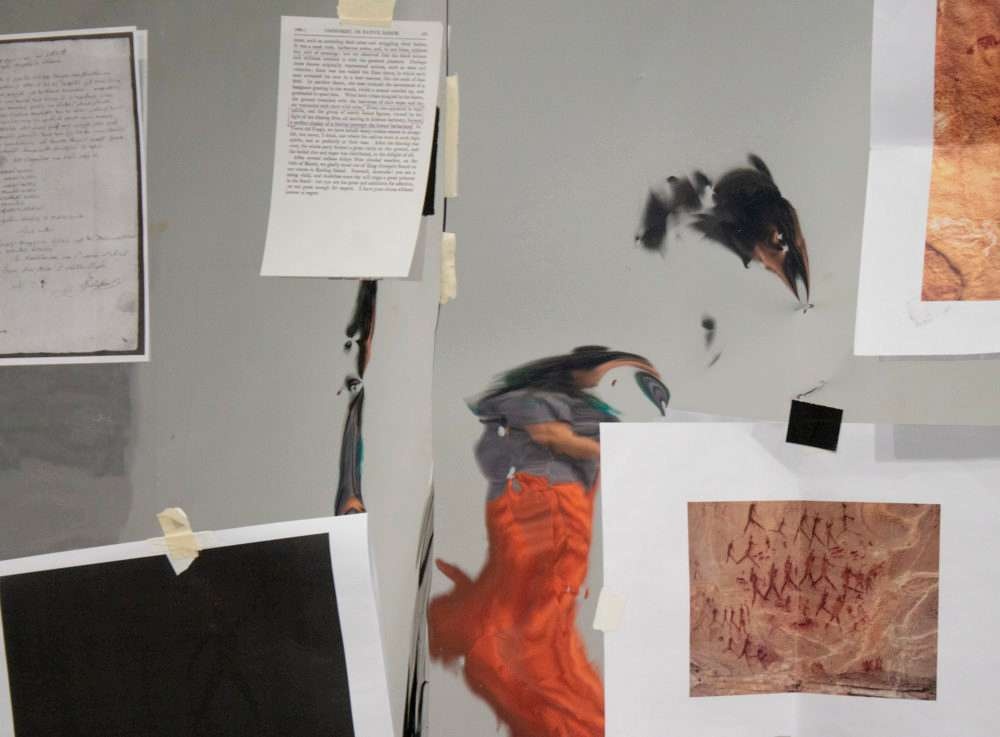

Detail of a wall during the Session Out of Control at Recess, 2018.
Camilo’s choreographic and pedagogical practices feels similarly susceptible to its environs. Quieting what is thought to be constitutive to the creative product opens the work onto elements ordinarily drowned out. John Cage recounts that seeing Robert Rauschenberg’s White Paintings, large scale white monochromes on canvas, was part of the inspiration for his own 4’33,” a musical performance composed almost entirely of the sounds of the environment. [1] These paintings “caught whatever fell on them.” [2] It is not that there is no structure or choreographic score in place in Camilo’s work, but that there is an openness to receive as much as there is to transmit.
The unruly mylar surface also becomes a portal to the world beyond, a ground onto which Camilo’s various inspirations guide his practice and hold the space. Affixed on the mylar are blown-up copies of various texts. There’s Maya Angelou’s insistence on getting the work done and affirmation that artistic practice should be integrated into everyday life: The work is all there is. And when it’s done, then you can laugh, have a pot of beans, stroke some child’s head, or skip down the street.[3] This call is echoed in “10 Rules for Students and Teachers” famously adapted by John Cage: There is no win and fail. There is only make (Rule 6). The only rule is work (Rule 7).[4] In another passage, Yvonne Rainer describes her admiration of George Sugarman’s ability to work through the pains of financial scarcity and emotional setbacks.[5] There is Audre Lorde, after having written The Cancer Journals, urging fellow Black women writers to write through fear and through exhaustion: […] we learn to work when we are tired, so we can learn to work when we are afraid.[6] These are not appeals to productivity for productivity’s sake, but as commitment to working through feeling, to let vulnerability seep through and guide the work that we do. Collectively and individually, these written quotations function almost like choreographic scores, as agreements with oneself and with others that reflect what one is striving towards and resisting against.
Also affixed to the walls are 16th and 17th century settler accounts of colonial encounters in Brazil and Cuba warning of witchcraft and surveilling indigenous traditions involving dancing as ecstatic ritual. Alongside the texts are images that illustrate different modes of togetherness. Yvonne Rainer and Steve Paxton performing Word Words in the Judson Church basement in 1963 model the play between difference and sameness, their bodies stripped to reveal more commonality than division. There are also examples from Camilo’s Choreographic Studies which amass ancient and non-Western depictions of bodies grouped together in sex and dance or both, from ukiyo-e orgiastic scenes to Moche and Greek ceramics. In his workshops, Camilo uses these as departure points for movement exercises, affirming that the ways our bodies interact in intimate and everyday ways can provide a framework for dance.
Throughout the run of his Session, Camilo opens up the space to different performers, inviting a roster of non-white and queer artists similarly invested in contesting colonial frameworks, thereby refracting the frame of the individual artist residency to render the space susceptible, generously porous. Each is free to adapt the space, leading workshops grounded in their specific practices and strategies. As participants, we engage the space differently according to the shifts in how the space is held. In the way that his Amigxs photo project asserts our interconnectedness by showcasing a range of subjects, the multiplicity of movement strategies emphasize that community is built by the commitment to show up and make ourselves vulnerable to new ways of engaging with each other. In an age where our identities have been commodified to such extremes, the space Camilo creates fosters the individual and collective ability to remain pliable, to center and acknowledge our differences and to build something together that still has the ability to slip, move, reflect, shine, distort, reconfigure. The connecting thread between what Camilo renders in movement and image is the study of how intimacies weave through our lives. Camilo’s work is not only of the world but brings presence to what that being in the world feels like. It is a world built of interrelations, the coming together of people by chance and by force, through pleasure and oppression.
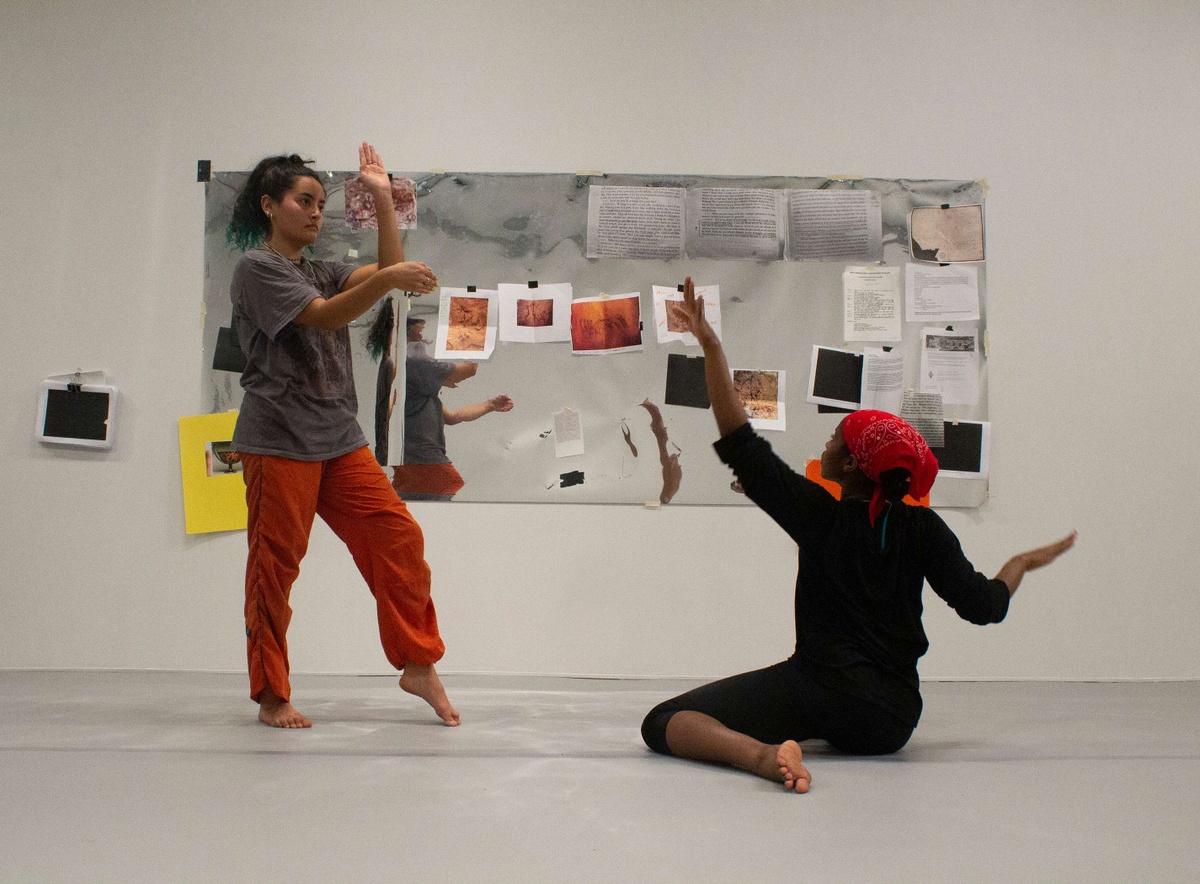

Julianne Cariño and Yolette Yellow-Duke dancing at Recess, 2018.
One more set of photos hangs by the mylar: a series of photographs of rehearsals for Camilo’s What did they actually see?, a choreographic project developed and performed in darkness, derived partially from explorations between the body and the aforementioned colonial texts. [7]Those present for Camilo’s July 2018 solo performance for this project in the compact Leslie-Lohman Project Space basement relinquished the visual pleasure of dance in exchange for small glimpses of Camilo’s movements as their eyes adjusted or as a residue of a light rendered his form temporally visible. Sounds magnified; nervous shuffles in seats were audible. The dampness of Camilo’s sweat and of others in the July heat filled the space. As registers of this ongoing project, the photos read almost like black monochromes, with the occasional specter of Camilo’s form. I’m reminded of Adrian Piper’s Food for The Spirit series (1971), a work driven by the tension between transcendence and groundedness, between solitude and the desire to connect. Piper standing before a mirror every day registers her presence. She is at times nearly indistinguishable from the background—underexposed then overexposed—but nonetheless present. In many ways, Camilo’s residency mirrors this practice. Every day showing up, every day making, every day presencing in front of the unreliable mirror.
– Vivian Crockett
Footnotes
-
John Cage, “On Robert Rauschenberg, Artist, and His Work” (1961), in Silence (Middletown, CT: Wesleyan University Press, 1961), 98. For a detailed discussion of this and the conceptual relationship between Cage and Rauschenberg, see: Branden W. Joseph, “White on White,” Critical Inquiry27, no. 1 (Autumn 2000): 90-121.
-
Cage 108
-
Maya Angelou qtd. in Claudia Tate, ed., Black Women Writers at Work (New York: Continuum, 1983), 4.
-
Although commonly attributed to Cage, these rules were originally written by Sister Corita Kent and students at the Immaculate Heart College. The document is titled 10 Rules ‘from John Cage’ rather than ‘by John Cage.’ Correspondence between Camilo Godoy with Merce Cunningham Trust and Corita Art Center, January 2019.
-
Yvonne Rainer, Feelings Are Facts: A Life (Cambridge, MA: MIT Press, c 2006), 171.
-
Audre Lorde qtd. in Tate 116
-
At Recess, the project has evolved and been co-developed with dancers Julianne Cariño, Miguel Angel Guzmán, and Yolette Yellow-Duke.
About the artist
Explore/Archive
See allDecember 2025
The INSTITUTE FOR TRANSHUMANIST CEPHALOPOD EVOLUTION and Learning from Octopuses
Barbara London
Barbara London reflect's of Miriam SImun's INSTITUTE FOR TRANSHUMANIST CEPHALOPOD EVOLUTION
October 2025
streamlined reflections, courtesy of noise canceling headphones
Gabrielle Rucker
Gabrielle Rucker reflects on the radical intimacy and auditory life at the heart of Deli Radio
July 2025
Tell My Jockey: CUNTRY’s Discourse From the Horse’s Mouth
Ericka Pérez
Assembly fellow Ericka Pérez reflects on clowning, resistance, and CUNTRY’s radical refusal to perform.
